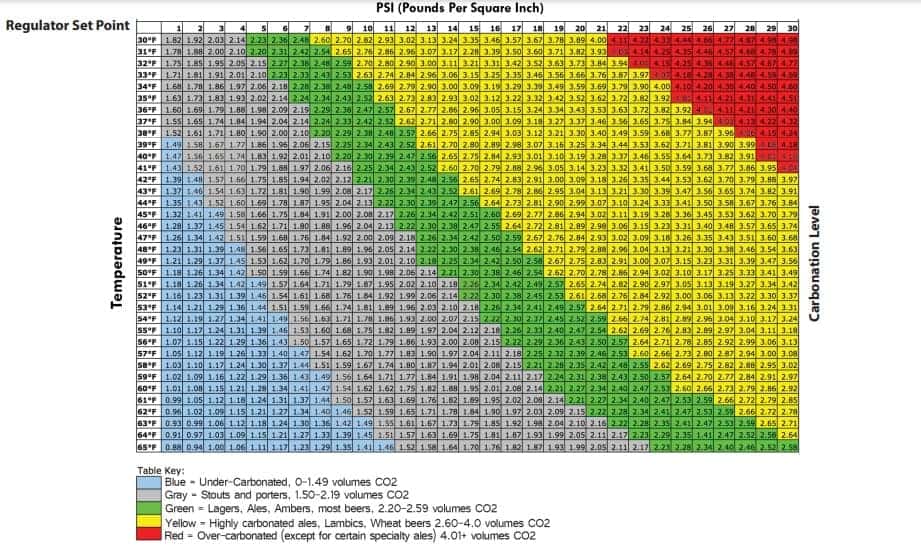Learning how to force carbonate beer is a simple process: At its core force carbonating involves simply transferring your beer to a keg and carbonating it by infusing it with CO2 gas instead of the traditional method of transferring it to bottles, adding sugar, and letting the yeast create the CO2.
Equipment Required to Force Carbonate Beer
The following equipment you require is easily sourced at any online homebrew supply store:
- A corny keg (either ball lock or pin lock will work)
- A full CO2 tank
- Regulator for the CO2 tank
- Liquid & gas lines with fittings
- A keezer or refrigerator
Force Carbonation Methods 

When it comes to force carbonating your beer there are basically 3 methods you can choose from to do so. The first two methods both deliver very good levels of carbonation, the third method is only recommended when you have an immediate need for carbonated beer.
Force Carbonation Chart
Before we get into the 3 methods we thought we would say a little word about carbonation charts. If you are a very technical person and wish to precisely dial your carbonation levels in then you can use a chart to help you do so.
Many brewers use these charts, we do not. This is Make Beer Easy after all and to be upfront we have never noticed a significant difference between the quality of beer using a carbonation chart versus one that follows what we will outline in the first two methods below. However, if you wish to use a chart the following is a very popular one from blichmann that many brewers use.

Method #1: 48 Hours
This method to force carbonate beer is our recommended method. In fact, at Big Robb’s brew pub this was the method that was used to carbonate all of the beers served. It is also the only method that we now use when carbonating any of our homebrew.
- Let the beer sit in fermenter for at least two days after having reached final gravity
- Cold crash your beer in a fridge or keezer for 48 hours
- Transfer your beer from fermenter to a sanitized keg
- Connect the gas line, and turn the gas up to 35 psi to seal the lid
- It is recommended to purge the keg 3 – 5 times with CO2 to rid it of oxygen
- Place keg and CO2 in fridge or keezer
- Leave gas turned on for 24 hours at 35 psi.
- After 24 hours turn gas off and let the beer sit for another 24 hours
- Beer will now be ready to serve, turn gas down to serving pressure, you may have to release the gas from the keg once before serving.
Method #2: 7 – 10 Days
This method is similar to the first method, however, you will carbonate using a lower level of CO2 over a longer period of time.
Follow all of the steps outlined above, except set the pressure in your gas to your serving pressure level. It will vary between systems, but anywhere from 10 – 15 psi is typical for this method.
Now put the fermenter and CO2 tank in your freezer or fridge and leave it for 7 – 10 days. You can check it from time to time to see if your desired carbonation level has been reached.
Method #3: 2 – 3 hours
This method is only recommended if you require beer immediately. It will provide you with what appears to be carbonated beer, but in many cases is more foamy beer than carbonated as the CO2 has not had enough time to properly infuse into the beer, but it is far better than flat beer, certainly drinkable, and will definitely do the job in a pinch.
Follow the original steps as outlined in the other two methods discussed.
- Then hook the gas line up and set the regulator to 35 psi.
- Next roll the keg on the ground or a table or even on your lap for 15 minutes.
- Next, lower the psi to 20 and let the keg sit for 2 – 3 hours.
- Test your beer, if it is overly foamy, release the gas from the pressure relief valve.
- You may also find that you have to serve this beer at a lower serving pressure or it will be too foamy.
The Final Word
There you have it the 3 methods to force carbonate beer. All 3 methods work, the first 2 are far superior to the last one and are our recommended methods but all 3 will provide you with a carbonated beer. And all 3 are much easier methods than bottling your beer and naturally carbonating with sugar.
If you have any questions on how to use these methods feel free to reach out to us in the comments. Good luck and enjoy not having to bottle any longer!
P.S. Be sure to check out our offer to get Robb’s top 5 recipes from his brewpub, details are on the side of the blog. Cheers!
